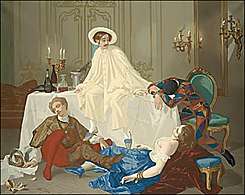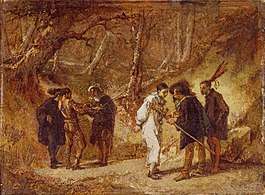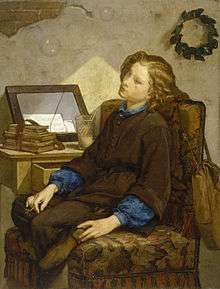Thomas Couture
Thomas Couture (21 December 1815 – 30 March 1879) was a French history painter and teacher. He taught such later luminaries of the art world as Édouard Manet, Henri Fantin-Latour, John La Farge,[1] Pierre Puvis de Chavannes, Karel Javůrek, and J-N Sylvestre.
Thomas Couture | |
|---|---|
 Thomas Couture, self-portrait | |
| Born | Thomas Couture 21 December 1815 Senlis, Oise, France |
| Died | 30 March 1879 (aged 63) Villiers-le-Bel, Val-d'Oise, France |
| Resting place | Père Lachaise Cemetery, Paris, France |
| Nationality | French |
| Education | École des Arts et Métiers |
| Known for | Painting, Author |
Notable work | Romans in the Decadence of the Empire |

Life
Early life and education
Couture was born at Senlis, Oise, France. When he was 11 his family moved to Paris, where he would study at the industrial arts school (École des Arts et Métiers) and later at the École des Beaux-Arts.
Art and teaching career
He failed the prestigious Prix de Rome competition at the École six times, but he felt the problem was with the École, not himself. Couture finally did win the prize in 1837.
In 1840 he began exhibiting historical and genre pictures at the Paris Salon, earning several medals for his works, in particular for his masterpiece, Romans During the Decadence (1847). Shortly after this success, Couture opened an independent atelier meant to challenge the École des Beaux-Arts by turning out the best new history painters.
Couture's innovative technique gained much attention, and he received Government and Church commissions for murals during the late 1840s through the 1850s. He never completed the first two commissions, and the third met with mixed criticism. Upset by the unfavorable reception of his murals, in 1860 he left Paris, for a time returning to his hometown of Senlis, where he continued to teach young artists who came to him. In 1867 he thumbed his nose at the academic establishment by publishing a book on his own ideas and working methods called Méthode et entretiens d'atelier (Method and Workshop Interviews). It was also translated to Conversations on Art Methods in 1879, the year he died.
Asked by a publisher to write an autobiography, Couture responded: "Biography is the exaltation of personality—and personality is the scourge of our time."
Death
In 1879 he died at Villiers-le-Bel, Val-d'Oise, and was interred in Père Lachaise Cemetery, Paris.
Selected paintings
.jpg)
- Anselm Feuerbach (1852)
 The Supper after the Masked Ball [1857]
The Supper after the Masked Ball [1857] The Duel After the Masked Ball (1857)
The Duel After the Masked Ball (1857) Daydreams (1859).
Daydreams (1859). A Lawyer Going to Court (1860s)
A Lawyer Going to Court (1860s)
References
- Wilkinson, Burke. The Life and Works of Augustus Saint-Gaudens, Dover Publications, Inc., New York. p. 79.
Further reading
- O'Neill, J., ed. (2000). "Index". Romanticism and The School of Nature: Nineteenth-century drawings and paintings from the Karen B. Cohen collection. New York: The Metropolitan Museum of Art.
External links
| Wikisource has the text of the 1911 Encyclopædia Britannica article Couture, Thomas. |

- Thomas Couture at Find a Grave
- Article on Thomas Couture